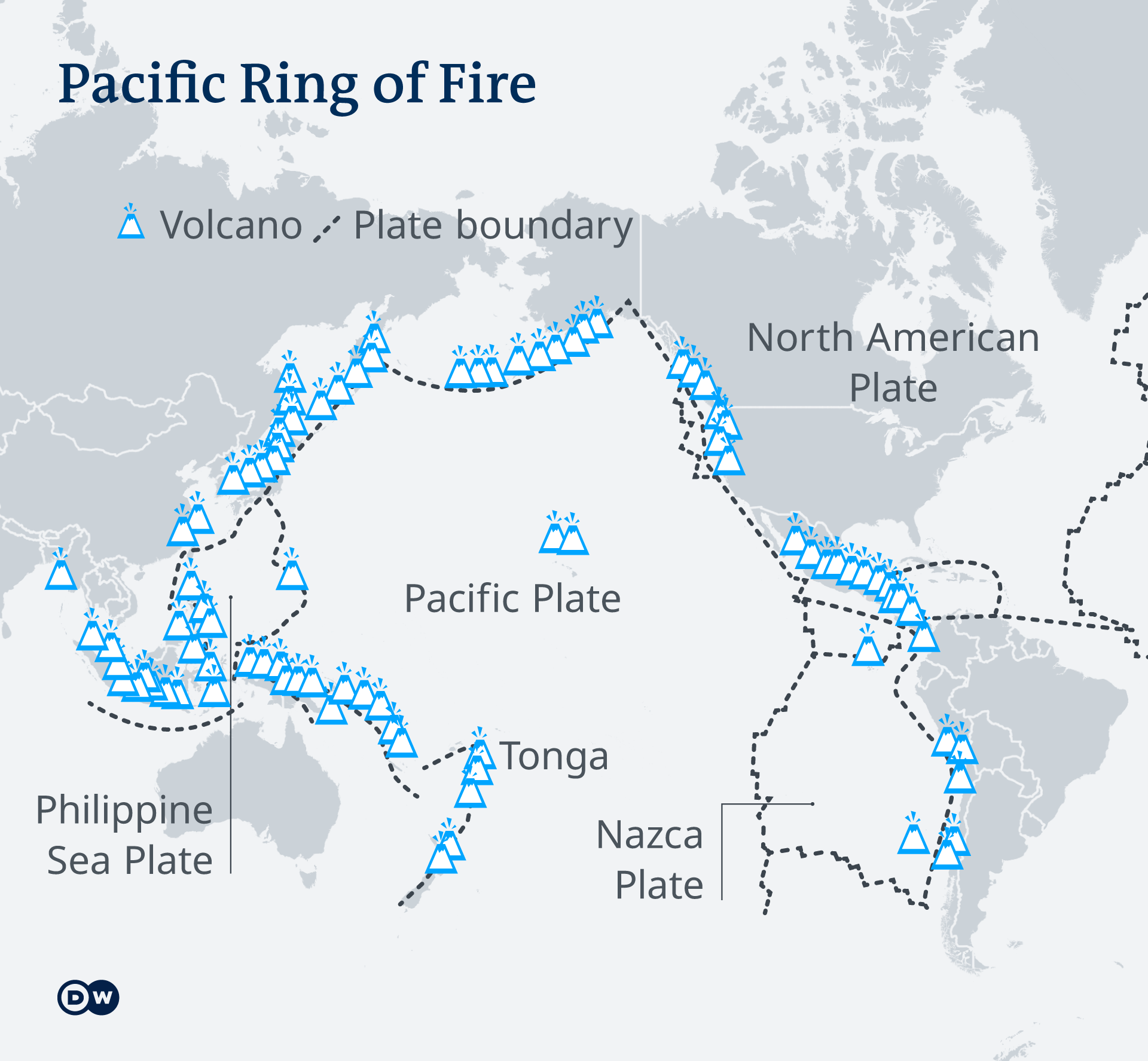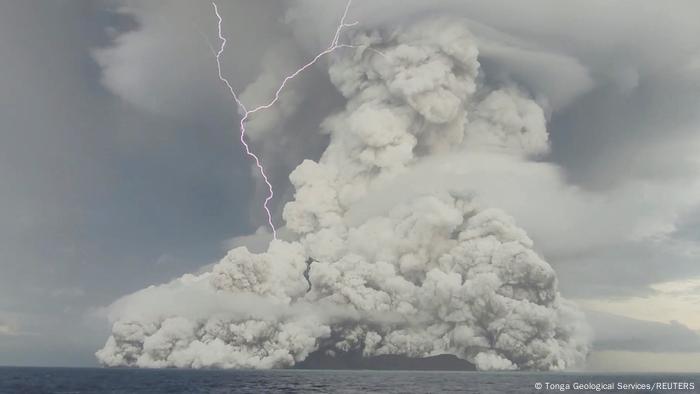Most volcanic activity happens beneath the ocean — but we often don't know about it. DW looks at how underwater volcanoes form and what happens when they erupt.
The extent of the damage from the eruption of the underwater volcano is still unknown
It's usually the volcanoes we can see that get our attention. But a violent underwater volcanic eruption on the Pacific island of Tonga in mid-January has people looking at the volcanoes beneath the ocean.
"Two-thirds of all volcanic activity happens in the deep sea," said Christoph Helo, a volcanologist at the University of Mainz in Germany.
The underwater eruption in Tonga caused a tsunami that flooded parts of the country's capital. But generally, these underwater explosions come and go without much fanfare.
"Most volcanoes on our planet are indeed underwater volcanoes — this is nothing peculiar. They just erupt very quietly (not explosively) so nobody takes notice," Helo told DW.
The exact number of active underwater or submarine volcanoes is not known, but estimates range from hundreds to thousands, said Tamsin Mather, a volcanologist and professor of earth sciences at the University of Oxford.
TONGA VOLCANO ERUPTION SENDS TSUNAMI WAVES ACROSS PACIFICVolcano erupts off of TongaA volcano near the island nation of Tonga erupted on Saturday, sending tsunami waves across the Pacific. The massive eruption has severely hampered international communication with the island.
How do underwater volcanoes form?
"There is no specific difference in the formation of submarine (underwater) and subaerial (on land) volcanoes," Helo told DW.
Volcanoes form when molten rock is produced in the second layer of the Earth's interior — the mostly solid upper mantle — and makes its way through the crust.
"Most submarine volcanism is associated with the continuously active volcanism along mid-ocean ridges, where two tectonic plates are pulling apart," said Mather.
The collision of two plates can also cause a volcano. If both tectonic plates are beneath the ocean, then the volcano will develop underwater, said Helo. Over time, they may grow to form volcanic islands, he added. Volcanic activity within a single tectonic plate can also result in the formation of a volcano. This can happen when there is a hotspot underneath an oceanic plate, creating a chain of volcanic islands like Hawaii.

What happens when an underwater volcano erupts?
The impact of an underwater volcano eruption depends on its proximity to the water's surface.
"If the eruption happens at very great depths underwater, then the weight of the overlying water acts as a pressure cap," said David Pyle, a volcanologist and professor of earth science at the University of Oxford.
If a piece of molten rock enters the sea two kilometers (1.24 miles) below the surface, it will come into contact with cold seawater and cool very quickly. The water will get very hot, but it won't turn into steam.
But if the water is shallow enough, the magma starts to heat the water, which is then converted into steam. This creates a big change in volume.
"Steam explosions are really destructive because a small volume of water turns into a huge volume of steam," Pyle told DW.
Aside from the risk of tsunamis, the mass of ash ejected into the air when an underwater volcano erupts in shallow water can have a serious impact on people's health.
The falling ash and emitted gases not only pollute the air but can affect access to electricity and water supplies, said Pyle
The impact of an underwater volcano eruption depends on its proximity to the water's surface.
"If the eruption happens at very great depths underwater, then the weight of the overlying water acts as a pressure cap," said David Pyle, a volcanologist and professor of earth science at the University of Oxford.
If a piece of molten rock enters the sea two kilometers (1.24 miles) below the surface, it will come into contact with cold seawater and cool very quickly. The water will get very hot, but it won't turn into steam.
But if the water is shallow enough, the magma starts to heat the water, which is then converted into steam. This creates a big change in volume.
"Steam explosions are really destructive because a small volume of water turns into a huge volume of steam," Pyle told DW.
Aside from the risk of tsunamis, the mass of ash ejected into the air when an underwater volcano erupts in shallow water can have a serious impact on people's health.
The falling ash and emitted gases not only pollute the air but can affect access to electricity and water supplies, said Pyle
Lack of access, lack of data
Perhaps unsurprisingly, the fact they are underwater makes submarine volcanoes difficult to study.
"Only a few active sites have been studied in detail due to their inherent inaccessibility," Mather told DW.
Scientists working on land can learn about the history of a volcano by visiting the volcano site and gathering data. This can be done using cliff sequences or digging holes and collecting materials.
For underwater volcanoes, scientists usually have to rely on marine surveys and mapping technology like sonar.
"It's like a really complicated layer cake," says Pyle, "somebody is going to cook this pretty complicated cake and then bash it around and cut a hole in it, and if it's above water, you can just go and have a look at it, and if they've dropped it in the bath then you're really stuck."
Edited by: Clare Roth
Perhaps unsurprisingly, the fact they are underwater makes submarine volcanoes difficult to study.
"Only a few active sites have been studied in detail due to their inherent inaccessibility," Mather told DW.
Scientists working on land can learn about the history of a volcano by visiting the volcano site and gathering data. This can be done using cliff sequences or digging holes and collecting materials.
For underwater volcanoes, scientists usually have to rely on marine surveys and mapping technology like sonar.
"It's like a really complicated layer cake," says Pyle, "somebody is going to cook this pretty complicated cake and then bash it around and cut a hole in it, and if it's above water, you can just go and have a look at it, and if they've dropped it in the bath then you're really stuck."
Edited by: Clare Roth


No comments:
Post a Comment